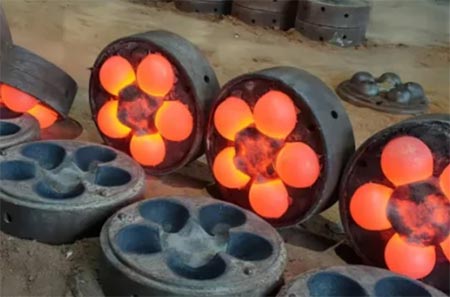How to make a steel ball?
Views: 1410 Update Date:May 15 , 2024
Making a steel ball typically involves a process called "ball blanking" or "ball forming." Here's a general outline of how it's done:
1. Material Selection: Choose the type of steel suitable for your purpose. Typically, hardened steel or stainless steel is used for making steel balls due to their durability and resistance to corrosion.
2. Cutting: The first step is to cut the steel into a rough spherical shape. This can be done using various methods such as forging, casting, or machining. Forging involves heating the steel and shaping it using dies, while casting involves pouring molten steel into spherical molds. Machining involves cutting the steel using lathes or CNC machines.
5. Final Grinding: After heat treatment, the steel balls are ground again to achieve the final diameter, roundness, and surface finish. This step ensures that the steel balls meet the required specifications for size and shape.
6. Quality Control: Throughout the manufacturing process, quality control measures are implemented to ensure that the steel balls meet the required standards for hardness, diameter, roundness, and surface finish. This may involve using measuring equipment such as calipers, micrometers, and roundness testers.
7. Finishing: Once the steel balls have been manufactured and inspected, they may undergo additional finishing processes such as polishing or coating to improve their appearance or provide additional protection against corrosion.
It's worth noting that the specific process for making steel balls may vary depending on factors such as the size of the balls, the quantity being produced, and the intended application. Additionally, specialized equipment and expertise are often required for manufacturing high-precision steel balls used in applications such as bearings or valve balls.
Prev: How steel balls are made?
Next: What is the difference between ball mill and grinding balls?
1. Material Selection: Choose the type of steel suitable for your purpose. Typically, hardened steel or stainless steel is used for making steel balls due to their durability and resistance to corrosion.
2. Cutting: The first step is to cut the steel into a rough spherical shape. This can be done using various methods such as forging, casting, or machining. Forging involves heating the steel and shaping it using dies, while casting involves pouring molten steel into spherical molds. Machining involves cutting the steel using lathes or CNC machines.
3. Rough Grinding: Once you have the rough spherical shape, it needs to be ground to achieve the desired diameter and surface finish. This is typically done using grinding machines that rotate the ball against a grinding wheel or other abrasive surfaces.

5. Final Grinding: After heat treatment, the steel balls are ground again to achieve the final diameter, roundness, and surface finish. This step ensures that the steel balls meet the required specifications for size and shape.
6. Quality Control: Throughout the manufacturing process, quality control measures are implemented to ensure that the steel balls meet the required standards for hardness, diameter, roundness, and surface finish. This may involve using measuring equipment such as calipers, micrometers, and roundness testers.
7. Finishing: Once the steel balls have been manufactured and inspected, they may undergo additional finishing processes such as polishing or coating to improve their appearance or provide additional protection against corrosion.
It's worth noting that the specific process for making steel balls may vary depending on factors such as the size of the balls, the quantity being produced, and the intended application. Additionally, specialized equipment and expertise are often required for manufacturing high-precision steel balls used in applications such as bearings or valve balls.





